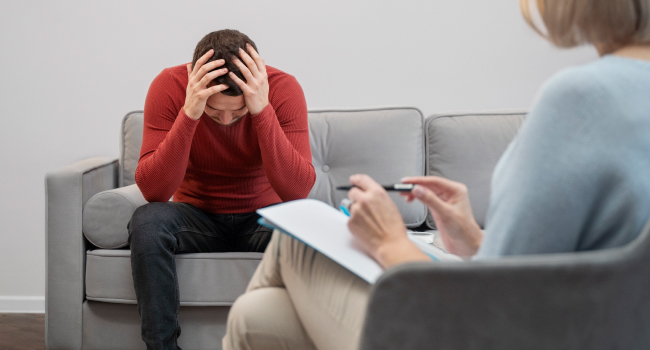Highlights
- Agoraphobia is an anxiety disorder associated with fear of situations where escape feels difficult; its symptoms last for six months or more.
- Agoraphobia affects around 1.3% of American adults and 2.4% of adolescents.
- Agoraphobia may be linked to genetics, stressful life events, or a panic disorder — it can occur with or without panic attacks, depending on the individual’s experiences.
- Effective treatments include cognitive-behavioral therapy (CBT), relaxation and stress management techniques, and gradual exposure, in some cases supported by medications.
Imagine you’re about to leave your home to go to the movies, when you’re suddenly overcome with an intense fear. The last time you went to the movies, you felt anxious. You started hyperventilating and sweating, and you felt trapped. You don’t want to feel that way again, so you stay home.
But over time, you notice that your fear doesn’t go away. This fear may lead your life to become more and more narrow, and you may leave your home (or other “safe” places) less and less frequently.
This is the experience of many people who live with an anxiety disorder called agoraphobia. It is closely related to panic attacks and can cause you to have such a severe fear of certain public scenarios that you start to experience problems at work and in relationships.
But there is hope

What Is Agoraphobia?
Agoraphobia is an anxiety disorder that affects around
Reports show that agoraphobia is even more common for adolescents —
There’s a common misunderstanding that agoraphobia is the fear of leaving your home, and that might be a simplified definition — but the scientific definition of agoraphobia in psychology is more complex. People with this condition have an extreme fear of being in places where escape would be difficult.
Because of this fear, many people with agoraphobia do feel afraid of leaving their homes, where they feel safe. But others with this condition have fears of being in other places, including public transportation, crowded places, and more.
Agoraphobia causes symptoms lasting 6 months or more. These symptoms also cause impairment to at least one area of your day-to-day life, whether it’s your work/school life or your relationships. This means that, because of your symptoms, you aren’t able to live life in the way you want to.
Agoraphobia Symptoms
Agoraphobia is categorized as an anxiety disorder in the Diagnostic and Statistical Manual (DSM), the text that health professionals use to make decisions about mental health diagnoses.
Some people define agoraphobia as a “fear of open spaces,” but in reality, its symptoms are more complex.
- Using public transportation
- Being in open spaces
- Being in enclosed spaces
- Being in a crowd or standing in a line
- Being out of your home alone
You might be afraid of these places because you feel you’ll get trapped there with no way to escape. Or you might be afraid of more specific scenarios, like falling, fainting, crying, sweating, or having diarrhea in public. Regardless of the specific reason, you feel intense anxiety when you’re in (or even think about being in) these situations.
If you live with agoraphobia, you feel afraid in these situations almost all the time, and you try to avoid being in these situations whenever possible. If you do need to be in these situations, you might need to have someone with you, or simply endure them with extreme discomfort and distress. You might feel trapped or be constantly on the lookout for ways you can escape.
In addition, your fear is out-of-proportion to the actual danger presented in these situations.
For example, if you live in an area with a high level of crime and community violence, then it’s reasonable to have a fear of going outside by yourself. If there are frequent recent accidents involving public transportation, then it’s natural for you to be fearful of riding public transportation. These examples might not qualify for a diagnosis of agoraphobia.

What Causes Agoraphobia?
There’s no single cause of agoraphobia. From the research so far, experts believe that many different factors — including
Some risk factors for agoraphobia include:
- Panic disorder: If you get panic attacks, then you’re at higher risk of also developing agoraphobia.
- Traumatic or frightening life events: You can also develop agoraphobia after experiencing a frightening event, like being the victim of a violent crime.
- Genetics: Having a close relative with agoraphobia usually means you’re at higher risk of developing it yourself.
Types of Agoraphobia
Agoraphobia can present in
Most people with agoraphobia also have a history of panic disorder — a mental health condition that causes frequent panic attacks, episodes of severe anxiety that can be almost debilitating. In panic disorder with agoraphobia, you develop a fear of certain public places because you’re afraid you’ll have a panic attack there.
Symptoms of a panic attack can include:
- A racing or pounding heart
- Feeling sweaty or clammy
- Shaking or trembling
- Struggling to catch your breath or feeling like you’re smothering
- A sensation of choking
- Tightness or discomfort in your chest
- Feeling nauseous or having an upset stomach
- Feeling lightheaded, dizzy, or like you might faint
- A sense that things around you don’t feel real or that you’re detached from yourself
- Feeling like you’re losing control or “going crazy”
- An intense fear that you’re dying
- Numbness or tingling in your hands, feet, or other parts of your body
- Feeling hot or cold suddenly, with chills or hot flashes
But not all people with agoraphobia have panic attacks. In agoraphobia without panic disorder, you can be afraid of being in the mentioned situations or places, not because you’re afraid of having a panic attack, but simply because you’re afraid of the situation itself.
Diagnosing Agoraphobia
If you think you may have agoraphobia, then getting the right diagnosis is the first step to receiving the treatment you need and deserve.
There is no medical exam, like an MRI or a blood test, that can definitively determine an agoraphobia diagnosis. It is diagnosed by comparing your symptoms to the official diagnostic criteria that are listed in the DSM (which we went over above).
Your healthcare provider might ask you questions about your specific experiences and symptoms as well as your medical history. This helps them understand if you really do have agoraphobia or if your symptoms might be a result of another mental health condition. The treatment for different anxiety disorders varies, so it’s important for them to nail down what’s really going on.
For example, if you have a fear of only one specific situation, but not others — for example, if you feel afraid in movie theaters but not anywhere else — then you may live with situational-type specific phobia, not agoraphobia. If your fear has more to do with the way others might perceive or judge you, rather than being in the situations themselves, then a diagnosis of social anxiety disorder might be more appropriate.
This is why it’s so important to see a qualified medical provider for assessment and diagnosis. By getting the right diagnosis, you can get appropriate treatment and start taking steps to overcome agoraphobia. With MEDvidi’s online anxiety treatment, you’ll receive expert guidance to address agoraphobia and take meaningful steps toward recovery.
Agoraphobia Treatment
You’re not likely to “get over” agoraphobia on your own — most people need professional treatment. According to the DSM,

Medication
There are no FDA-approved medications for agoraphobia specifically, but your medical provider might recommend some antidepressant or
Some possible options include:
- Selective-serotonin reuptake inhibitors (SSRIs), a type of antidepressants that include medications like Zoloft (sertraline) and is sometimes used for anxiety
- Serotonin and norepinephrine reuptake inhibitors (SNRIs), another type of antidepressants including medications like Effexor (venlafaxine)
- Benzodiazapines, a type of anti-anxiety medication
Medications might be especially helpful if you live with an underlying panic disorder. By having medication on-hand to manage your panic attacks, you might find that you’re less fearful about being caught in certain public scenarios.
Therapy
One of the
Some specific CBT techniques that are used for treating agoraphobia with and without panic disorder include:
- Cognitive restructuring: This technique helps you identify and challenge negative or distorted thoughts that might be fueling your fears about being in certain situations. For example, if you often think, “I’ll panic and embarrass myself if I go to the store,” cognitive restructuring helps you examine the evidence for and against this thought, replacing it with a more balanced and realistic perspective. Over time, this can reduce the anxiety tied to those situations.
- Relaxation training: Relaxation techniques, such as deep breathing, progressive muscle relaxation, or guided imagery, help reduce the physical symptoms of anxiety, like a racing heart or tense muscles. Learning to calm your body when you feel overwhelmed can make it easier to approach feared situations with a sense of control.
- Gradual exposure: Gradual exposure, also known as systematic desensitization, involves slowly and repeatedly facing the situations or places that trigger your fear, starting with less frightening scenarios and building up to more challenging ones. This process helps you gradually realize that these situations are not as dangerous as they feel and builds your confidence in managing anxiety over time. For example, if you’re afraid of crowded places, you might start by standing outside a busy store and eventually work up to shopping inside. For the best results, it’s recommended to see a mental health professional specializing in exposure therapy.
Coping Tips
There are also some self-help techniques that you can use to try to manage agoraphobia, although these can’t replace professional treatment if you need it. Generally, it’s best to borrow practices from CBT that have been shown to help for agoraphobia. You can practice these skills on your own time, even if you’re already working with a therapist.
Try using these coping tips:
- Use relaxation techniques, like breathing strategies, to cope with anxiety.
- Try to challenge irrational beliefs or thinking patterns that may be making your fears more intense. You might complete a “thought log” — write down what thoughts you’re having, as well as the event that triggered them and how they made you feel.
- Gradually expose yourself to situations that make you feel scared. It’s important to do this gradually. For example, instead of actually going to a public place, you might just imagine yourself going there. If you feel so afraid that you become debilitated, then it’s a sign that you’re pushing yourself too hard.
- Build a support system. Any mental health condition, including agoraphobia, is easier to manage when you have support. Identify trusted people in your life who you can count on, and let them know how they can help you. If you don’t feel comfortable confiding in people you know, you might consider joining an online support group for agoraphobia.
Key Takeaways
Agoraphobia can be scary to live with, and can even become debilitating when it’s left unaddressed. Worst of all, it can take so much away from you, and prevent you from living a life that truly brings you joy and fulfillment. But with the right treatment, people, including you, can learn to manage the symptoms and get their life back.
Get treatment for agoraphobia, panic attacks, and other anxiety disorders with MEDVidi — an appointment is just a click away.
FAQs About Agoraphobia
What triggers agoraphobia?
There is no singular cause of agoraphobia, but it can sometimes be triggered by a frightening or








